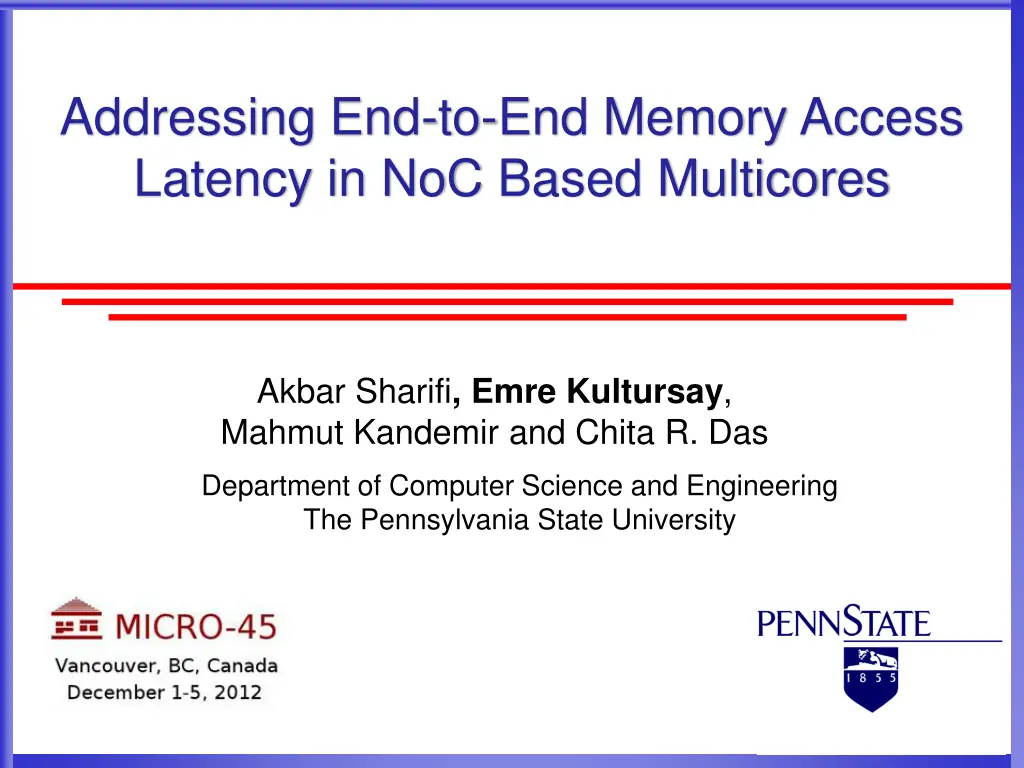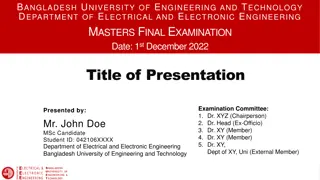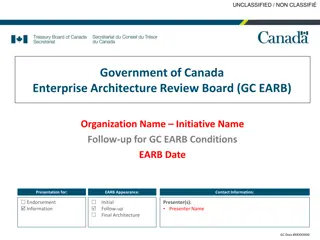
Addressing End-to-End Memory Access Latency in NoC-based Multicores
"Exploring strategies to reduce memory access latency in NoC-based multicore systems, focusing on addressing different components contributing to latency and proposing schemes for optimization." (355 characters)
Download Presentation

Please find below an Image/Link to download the presentation.
The content on the website is provided AS IS for your information and personal use only. It may not be sold, licensed, or shared on other websites without obtaining consent from the author. If you encounter any issues during the download, it is possible that the publisher has removed the file from their server.
You are allowed to download the files provided on this website for personal or commercial use, subject to the condition that they are used lawfully. All files are the property of their respective owners.
The content on the website is provided AS IS for your information and personal use only. It may not be sold, licensed, or shared on other websites without obtaining consent from the author.
E N D
Presentation Transcript
Addressing End-to-End Memory Access Latency in NoC Based Multicores Akbar Sharifi, Emre Kultursay, Mahmut Kandemir and Chita R. Das Department of Computer Science and Engineering The Pennsylvania State University
Outline Introduction and Motivation Details of the Proposed Schemes Implementation Experimental Setup and Results 2
Target System Tiled multicore architecture Mesh NoC Shared, banked L2 cache (S-NUCA) MCs MC MC Router Core L1 L2 bank Node MC Communication Link MC 3
Components of Memory Latency MC1 MC0 4 3 5 L2 Request Message Response Message 2 L1 1 MC3 MC2 Many components add to end-to-end memory access latency 4
End-to-end Memory Latency Distribution L1 to L2 L2 to Mem Mem Mem to L2 L2 to L1 Significant contribution from network 700 600 Delay (cycles) 500 400 Higher contribution for longer latencies 300 200 100 0 Delay Ranges (cycles) 0.25 Fraction of total accesses Average 0.2 Motivation Reduce the contribution from the network Make delays more uniform 0.15 0.1 0.05 0 100 300 500 700 900 Delay (cycles) 5
Out-of-Order Execution and MLP OoO execution: Many memory requests in flight Instruction Window Oldest instruction commits instruction window advances A memory access with a long delay Block instruction window Performance degradation end Instruction Window begin Load-A Load-B Load-C Load-D miss L2-hit L1-hit miss Network Network Network 6
Memory Bank Utilization 0.90 0.85 Large idle times More banks more idle times Idleness 0.80 0.75 0.70 1 2 3 4 5 6 7 8 9 10 11 12 13 14 15 16 Banks MC MC R-1 Variation in queue length Some queues occupied Some queues empty Bank 0 Motivation Utilize banks better Improve memory performance Bank 1 Bank 2 R-0 R-2 MC MC 7
Proposed Schemes Scheme 1 Identify and expedite late memory response messages Reduce NoC latency component Provide more uniform end-to-end memory latency Scheme 2 Identify and expedite memory request messages targeting idle memory banks Improve memory bank utilization Improve memory performance 8
Scheme 1 Based on first motivation Messages with high latency can be problematic NoC is a significant contributor Expedite them on the network Prioritization Higher priority to late messages Response (return path) only, why? Request messages not enough information yet Response messages easier to classify as late Bypassing the pipeline Merge stages in the router and reduce latency 9
Scheme 1: Calculating Age Age = so-far delay of a message 12 bits Part of 128-bit header flit No extra flit needed (assuming 12-bits available) ????????????? ?????????????_????? ????_???? ?????_????????? ??? = ??? + Updated at each router and MC locally No global clock needed Frequency taken into account DVFS at routers/nodes supported 10
Scheme 1: Example MC1 receives request from core-1 Age R0 Late R0 is the response message MC0 MC1 MC1 updates age field Adds memory queuing/service Use age to decide if late Mark as high-priority L2 Inject into network as high- priority L1 MC3 MC2 core-1 11
Scheme 1: Late Threshold Calculation Cores Continuously calculate average round-trip delay: ???????? Convert into ??????? ??? ???and then into ? ??? ??? Periodically send ? ??? ??? to MCs MCs Record ? ??? ??? values Use them to decide if late Each application is treated independently Not uniform latency across whole-system Uniform latency for each core/app round-trip-delay round-trip-delay so-far-delay round-trip-delay Delay_avg Delay_avg Fraction of total accesses Fraction of total accesses 0.30 0.30 Threshold Threshold 0.25 0.25 0.20 0.20 Delay_so-far-avg 0.15 0.15 0.10 0.10 0.05 0.05 0.00 0.00 100 100 300 300 500 500 700 700 900 900 Delay (cycles) Delay (cycles) 12
Scheme 2: Improving Bank Utilization Based on second motivation High idleness at memory banks Uneven utilization Improving bank utilization using network prioritization Problem: No global information available Approach: Prioritize at the routers using router-local information Bank History Table per-router Number of requests sent to each bank in last T cycles If a message targets an idle bank, then prioritize Route a diverse set of requests to all banks Keep all banks busy 13
Network Prioritization Implementation Routing 5 stage router pipeline Flit-buffering, virtual channel (VC) credit-based flow control Messages split into several flits Wormhole routing Our Method Message to expedite gets higher priority in VC and SW arbitrations Employ pipeline bypassing [Kumar07] Fewer number of stages Pack 4 cycles into 1 cycle Baseline Pipeline Bypassing BW RC VA SA ST setup ST 14
Experimental Setup Simulator: GEMS (Simics+Opal+Ruby) DDR-800 Memory Bus Multiplier = 5 Bank Busy Time = 22 cycles Rank Delay = 2 cycles Read-Write Delay = 3 cycles Memory CTL Latency = 20 cycles 16 banks per MC, 4 MCs 5 stage 128-bit flit size 6-flit buffer size 4 VC per port X-Y Routing 32KB 64B/line 3 cycle latency MC MC Router 4x8 Mesh NoC 512KB 64B/line 10 cycle latency 1 bank/node (32 banks total) Core L1 L2 bank 32 OoO cores 128 entry instruction window 64 entry LSQ MC MC 15
Experimental Setup Benchmarks from SPEC CPU2006 Applications categorized based on memory intensity (L2 MPKI) High memory intensity vs. low memory intensity [Henning06] 18 multiprogrammed workloads: 32-applications each Workload Categories WL 1-6: Mixed (50% high intensity -50% low intensity) WL 7-12: Memory intensive (100% high intensity) WL 13-18: Memory non-intensive (100% low intensity) 1-1 application-to-core mapping Metric ???? ??? ??????? = ?? = ????????? ?? ????????? ?????????? ?? =?? ????????? ??(????????) 16
Experimental Results 10% 13% Scheme-1 Scheme-1 + Scheme-2 Higher intensity benchmarks benefit more from Scheme 1 More traffic More late messages Normalized WS 1.20 1.15 1.10 1.05 1.00 0.95 0.90 w-2 and w-9 degrade w-1 w-2 w-3 w-4 w-5 w-6 Mixed Workloads Prioritizing some messages hurts some other messages 11% 15% 6% 10% Scheme-1 Scheme-1 + Scheme-2 Scheme-1 Scheme-1 + Scheme-2 Normalized WS Normalized WS 1.20 1.20 1.15 1.15 1.10 1.10 1.05 1.05 1.00 1.00 0.95 0.95 0.90 0.90 w-7 w-8 High Intensity Workloads w-9 w-10 w-11 w-12 w-13 w-14 w-15 w-16 w-17 w-18 Low Intensity Workloads 17
Experimental Results Before Scheme-1 1 Cumulative Distribution of latencies 8 threads of WL-1 90% point delay reduced from ~700 cycles to ~600 cycles Fraction of total accesses 0.8 0.6 0.4 0.2 0 Probability Density Moved from region 1 to region 2 Not all can be moved 0.25 Fraction of total 155 355 Total Delay (cycles) After Scheme-1 555 755 955 1 Fraction of total accesses Region 1 Region 2 0.8 0.20 0.6 New distribution accesses 0.15 0.4 Fewer accesses with high delays 0.10 0.2 0.05 0.00 0 100 300 500 700 900 155 355 Total Delay (cycles) 555 755 955 Delay (cycles) 18
Experimental Results Reduction in idleness of banks Dynamic behavior Scheme-2 reduces the idleness consistently over time default Scheme-2 default Scheme-2 0.85 0.90 Average Idleness 0.85 Idleness 0.80 0.80 0.75 0.75 0.70 0.70 0.65 1 3 5 7 Banks 9 11 13 15 1 3 5 7 9 11 13 15 17 19 Time Interval (100k cycles) 19
Sensitivity Analysis System Parameters Lateness threshold Bank History Table history length Number of memory controllers Number of cores Number of router stages Analyze sensitivity of results to system parameters Experimented with different values 20
Sensitivity Analysis Late Threshold Scheme 1: Threshold to determine if a message is late Default = 1.2 ????????= 1.7 ??????? ??? ??? Reduced Threshold: 1.1 ???????? More messages considered late Too many messages to prioritize can hurt other messages Increased Threshold: 1.4 ???????? Fewer messages considered late Can miss opportunities 1.1 x Delay_avg 1.2 x Delay_avg 1.4 x Delay_avg Normalized WS 1.15 1.1 1.05 1 0.95 0.9 w-1 w-2 w-3 w-4 w-5 w-6 21 Mixed Workloads
Sensitivity Analysis History Length Scheme 2: History length History kept at the routers for past T cycles Default value T=200 cycles Shorter history: T=100 cycles Cannot find idle banks precisely Longer history: T=400 cycles Less number requests prioritized T=100 T=200 T=400 Normalized WS 1.20 1.15 1.10 1.05 1.00 0.95 0.90 w-1 w-2 w-3 w-4 w-5 w-6 Mixed Workloads 22
Sensitivity Analysis Number of MCs Less MCs means More pressure on each MC Higher queuing latency More late requests More room for Scheme 1 Less idleness at banks Less room for Scheme 2 Slightly higher improvements with 2 MC 4 MC 2 MC Normalized WS 1.15 1.10 1.05 1.00 0.95 0.90 w-1 w-2 w-3 w-4 w-5 w-6 Mixed Workloads 23
Sensitivity Analysis 16 Cores Scheme-1 Scheme-1 + Scheme-2 Scheme-1 Scheme-1 + Scheme-2 1.15 1.15 Normalized WS Normalized WS 1.10 1.10 1.05 1.05 1.00 1.00 0.95 0.95 0.90 0.90 w-1 w-2 Mixed Workloads w-3 w-4 w-5 w-6 w-7 w-8 High Intensity Workloads w-9 w-10 w-11 w-12 Scheme-1 + Scheme-2 8%, 10%, 5% speedup About 5% less than 32-cores Scheme-1 Scheme-1 + Scheme-2 1.15 Normalized WS 1.10 1.05 1.00 Proportional with the # of cores Higher network latency More room for our optimizations 0.95 0.90 w-13 w-14 w-15 w-16 w-17 w-18 Low Intensity Workloads 24
Sensitivity Analysis Router Stages NoC Latency depends on number of stages in the routers 5 stage vs. 2 stage routers Scheme 1+2 speedup ~7% on average (for mixed workloads) 5-stage pipeline 2-stage pipeline Normalized Weighted Speedup 1.20 1.15 1.10 1.05 1.00 0.95 0.90 w-1 w-2 w-3 w-4 w-5 w-6 Mixed Workloads 25
Summary Identified Some memory accesses suffer long network delays and block the cores Banks utilization low and uneven Proposed two schemes Network prioritization and pipeline bypassing on late memory response messages to expedite them Network prioritization of memory request messages to improve bank utilization 1. 2. Demonstrated Scheme 1 achieves 6%, 10%, 11% speedup Scheme 1+2 achieves 10%, 13%, 15% speedup 26
Questions? Thank you for attending this presentation. Addressing End-to-End Memory Access Latency in NoC Based Multicores Akbar Sharifi, Emre Kultursay, Mahmut Kandemir and Chita R. Das Department of Computer Science and Engineering The Pennsylvania State University 27
References [1] A. Kumar, L. Shiuan Peh, P. Kundu, and N.K. Jha, Express Virtual Channels: Towards the Ideal Interconnection Fabric , in ISCA, 2007 [2] J. L. Henning, SPEC CPU2006 Benchmark Descriptions , SIGARCH Comput. Archit. News, 2006 28






















